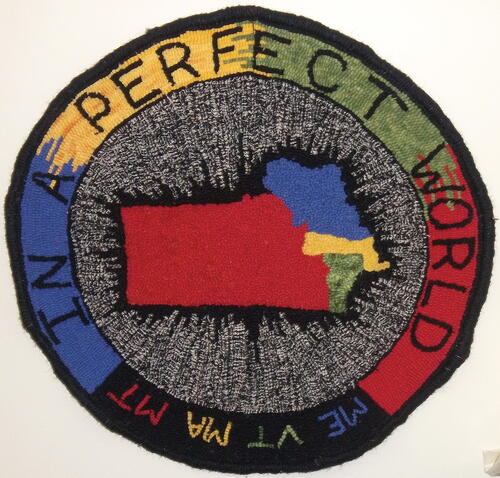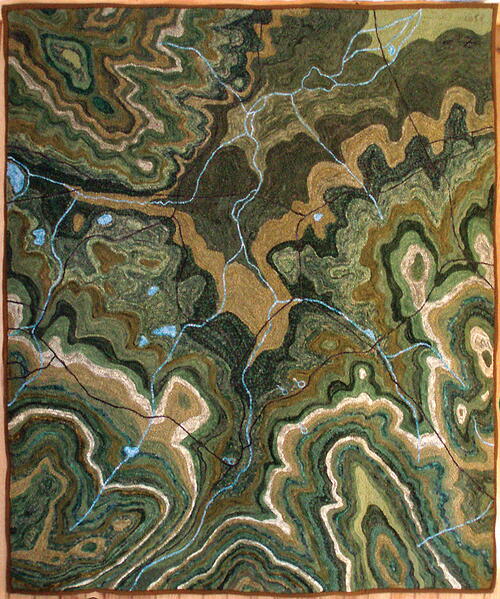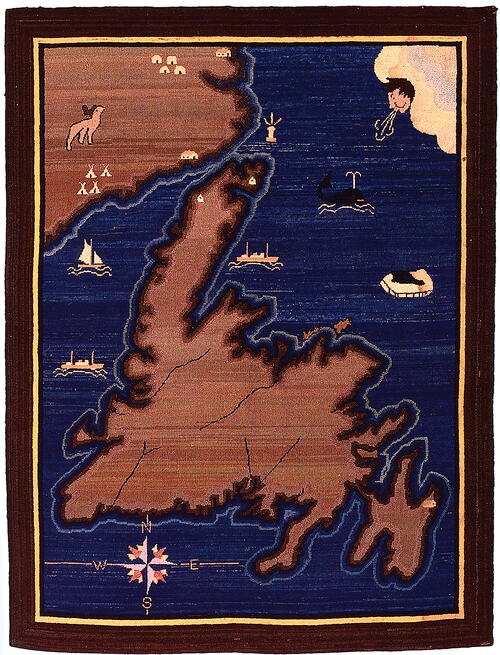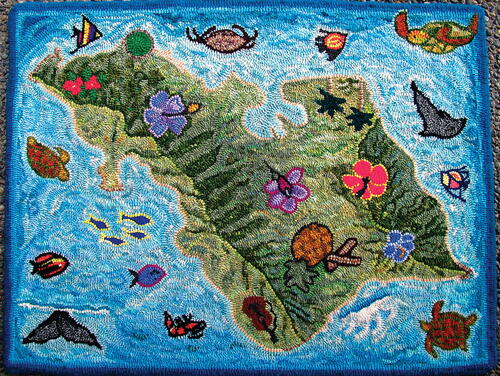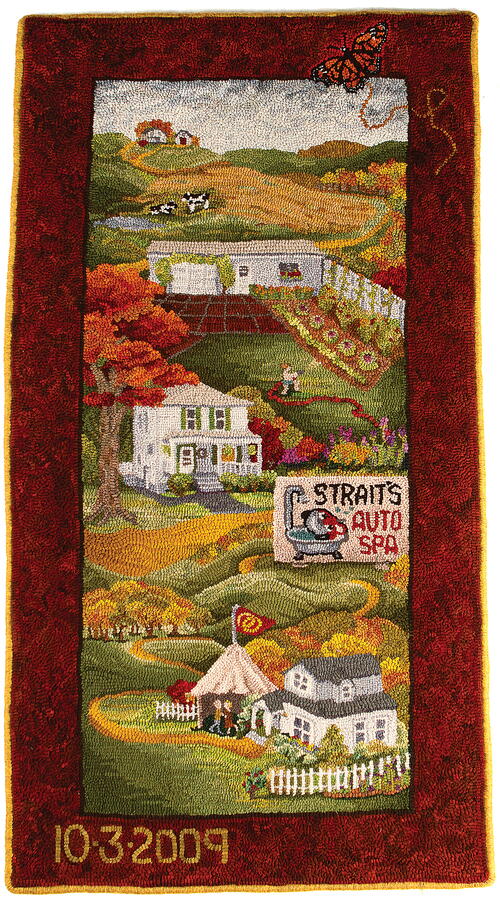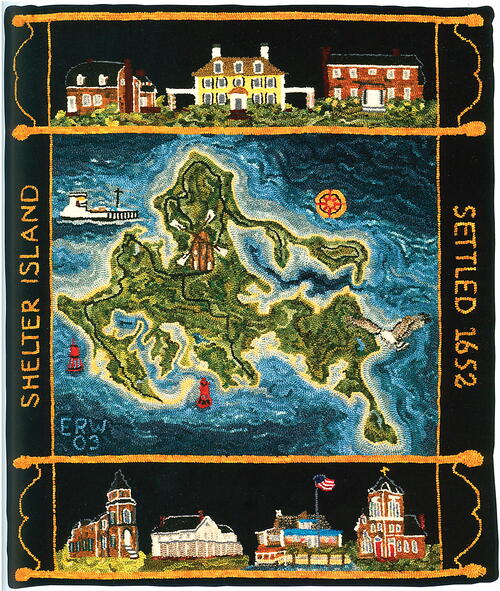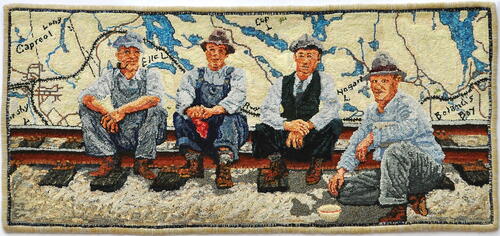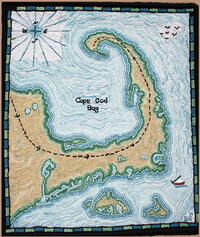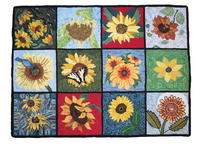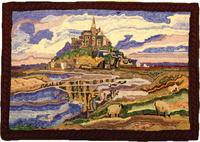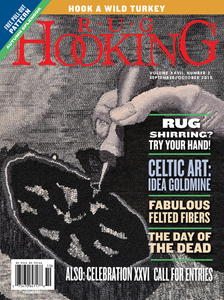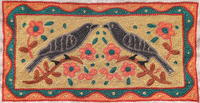Magnificent Hooked Maps
Using Maps to Tell a Story
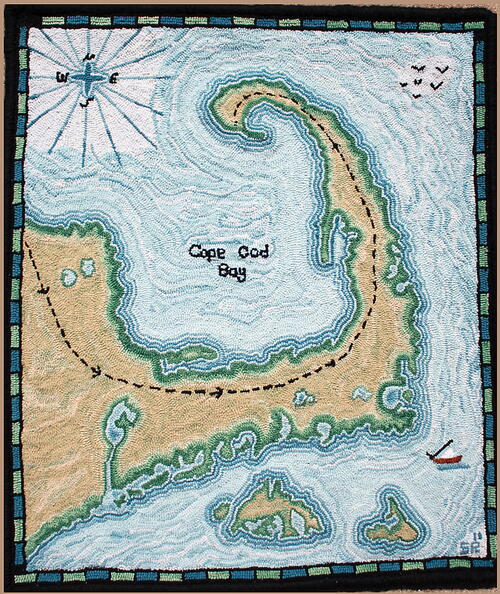
Digital maps are everywhere it seems. Where would we be these days without MapQuest, map apps on our smart phones, and GPS navigation in our cars? Those usually helpful, often annoying voices that direct us as we drive are our new-fangled substitute for those never-to-be-refolded-properly road maps from the local gas station.
But maps are much more than that. We never lose the urge to personally connect with our surroundings, both present and past. The map rugs you see here are rug hookers’ own personal maps, the maps of their lives. Each of them tells a story, and most of the stories are intensely personal. The mere fact that we painstakingly produce these map rugs speaks to the emotions they invoke: This is where I was when . . .
This was the homestead back in the day . . . This is where I would like to be . . .
Maps beckon. Maps tell stories. What is your story—have you hooked a map mat? Take a look at these rugs hooked by our creative map-loving readers. –Editor
“Regular maps have few surprises. . . . More precious, though, are the unpublished maps we make ourselves, of our city, our place, our daily world, our life; those maps of our private world we use every day . . . our personal memories that make the private tapestry of our lives.” —Alexander McCall Smith Love Over Scotland
-
Cape Cod Bay (main image), 26" x 30", #3-cut wool on monk’s cloth. Designed and hooked by Shirley Robinson, Wichita, Kansas, 2011.
One of the best ways to spend an afternoon is leafing through a pile of magazines. While going through some old issues from the downtown city library used book store, I came across an artistic rendition of the Apostle Islands in Midwest Living. This was my inspiration.
My husband is a huge University of Kansas basketball fan. We attend many out-of-state games, but one trip was special. Recovering from a near-death heart surgery, he needed to get away. Plymouth, Massachusetts, became home base for a week’s vacation.
Cape Cod is full of scenery, culture, and history. We landlubbers were taken with all the water, lighthouses, and local attractions. After dozens of drawings—I am not exaggerating the number!—I focused on Cape Cod, Plymouth to Provincetown. I found a National Geographic map of Massachusetts in the same library used book store, which became the example for the hand-drawn outline. Roz Tanquary, my rug hooking teacher, suggested making the shoreline irregular for a more natural look. She dyed the wool: five shades of blue, four greens, and three shades of beige.
The map hangs in our hallway as a memorial to my husband. I pass by it several times a day. The soothing blues are comforting. Blue is the favorite color in this family.
-
In a Perfect World, 18" diameter, #3-, 4-, and 5-cut wool on monk’s cloth. Designed and hooked by Mariah Krauss, Montpelier, Vermont, 2009.
When I moved to Montana for college, I didn’t realize just how far away from my family I would be or how infrequently I would see them. By my second year, I was unimaginably homesick and really missing my mom. She always taught me to “hook my feelings,” so for Christmas I decided to hook a rug for her that would show her just how much I loved and missed her. I cut out paper images of the four states that my mom, two sisters, and I lived in at the time—Vermont, Maine, Massachusetts, and Montana—and began to play with the design. I arranged them in what felt like a million different ways, but Montana was so much bigger than the others, and no matter what I did, the design was lopsided. Finally, my frustration got the better of me and I childishly jumbled them all together, feeling defeated.
When I was through with my short temper tantrum, I noticed that Montana had landed next to an upside-down Vermont and the edges fit together! I excitedly placed the other states around Montana and realized that, with very few alterations, all of the states could be close to each other and I could bring my family together—at least in my imagination.
And so, In a Perfect World was created. -
Topographic #72 Longitude: 77 degrees 18 minutes 9.288 seconds; Latitude: 39 degrees 56 minutes 2.04 seconds, 64" x 74", #5- and 6-cut wool on rug warp. Designed and hooked by Joan Strausbaugh, Biglerville, Pennsylvania, 2007.
Many years ago, when we moved to our home at the fishing club, my mom bought a section of a topographic map showing where we live. I found it fascinating. It always struck a chord with me.
Following my love of the line as a graphic element, I decided to hook a topographic map as a gift for my boss, Paul E. Spears. When I finally was ready to hook the valley where I live, I ordered a topographic map from the government, scanned in the appropriate “square,” and cleaned it up to remove names and any typography. Then I projected it onto rug warp. This whole process took me over eight hours.
I began my topographic rug at the Highlands Rug Camp with Gail Dufresne in March 2005. I dyed a mass of greens and tans and assigned one color to each elevation. I picked out a nice medium blue for all the creeks and streams, and an off-black for the roads. I hooked it all in #5 and #6 cuts.
At the York Fair in September 2006, I demonstrated rug hooking for the public, using a 6-foot-long floor frame from Fraser’s that rolled up the rug as I finished hooking each section. I was interested to notice that when men looked at this rug in progress, they immediately recognized it as a map, but the women—not so much. -
Paris, 29" x 23", #8-cut recycled wool on linen. Mav’e Brittain, Lexington, Kentucky, 2012.
My inspiration for Paris was a painting by Tucker Nichols and a conversation with a good friend who lives in Nashville. Susan told me that her favorite place in the world is Paris. Tucker Nichols’s painting is a grid of white lines on a charcoal gray background and looks like it could be a city map. I saw a coffee-table book of overhead photos of Paris, and my thought, as I looked at the photos, was that the place looked so gray. Those three lines of thought led to my “aha!” design moment. I decided to make a bedside rug for my friend so that she could step out of bed each morning and be in her favorite place. -
Map of Newfoundland, 31 1 /2" x 42", dyed silk and rayon on unknown backing. Signed L.H.H. and completed prior to 1935.
Editor’s note: I saw this mat on a visit to St. Anthony, Newfoundland, in the summer of 2011, and that is when the idea for this article began. This exquisite piece is a work of art, telling the story of the Grenfell Mission. It is shown here with permission from Paula Laverty, author of Silk Stocking Mats: Hooked Mats of the Grenfell Mission. Here is an excerpt from her book:
In October 1936, “The Homemaker,” a column in a Toronto newspaper, reported: “Beautiful rugs, incredibly fine and firm, hooked from discarded stockings . . . were on display and for sale. . . We fell into conversation with the nurse on furlough, Miss W. Murdoch, a rosy cheeked Scotch girl, and with her studied the fascinating map Sir Wilfred has made dotting it all over with wigwams, hospitals, nursing stations, schools, ships, great heaving walruses upsetting kayaks, wolves, moose, dog trains, igloos and a score of other objects that tell the story of the work among the people of the bleak Northland.” -
Oahu, Hawaii, 30" x 23", #4- and 5-cut new, dyed, and recycled wool on linen. Designed and hooked by Judy Schick, Vancouver, British Columbia, Canada, 2012.
I hooked this rug in memory of a wonderful family Christmas vacation in Oahu. We toured the island enjoying the snorkeling, turtles, big surf, shrimp shacks, ukuleles, and magnificent flora. One small area of the rug has a special meaning to me. As I was snorkeling in a lagoon, I got caught as the tide changed and was pulled out to sea. I managed to hold on to a rope, and when that broke, I was pulled onto some rocks and was finally rescued. I now have a much greater respect for the ocean. -
The Wedding, 24 1 /2" x 47 1 /2", #3- to 5-cut hand-dyed wool on linen. Designed and hooked by Janet Hamstead, Mt. Vernon, Ohio, 2011. CALEB MCCOY
This rug was my first pictorial. I started designing at the bottom, which depicts my daughter’s outdoor wedding at her grand-mother’s home. I did not know whether I would enjoy doing a pictorial, so I decided that if I didn’t enjoy hooking it, I would stop with the lower house and make it into a pillow. As you can see, I enjoyed it so much that I went on to include my daughter and son-in-law’s present home, garden, and garage. In the distance is the boyhood farm home of my son-in-law, which was to be razed; however, since the completion of the rug, they have decided to renovate the house and make it into their new home. So the rug is not only a map mat, but it’s also a timeline of our time together. TRISH JOHNSON -
Historic Shelter Island, 32" x 37 1 /2", #3-, 4-, and 6-cut wool on rug warp. Designed and hooked by Lissa Williamson, Severna Park, Maryland, 2003.
Lissa was thrilled when her rug was chosen for Celebration XV. This rug is a remembrance of a carefree time in her life, growing up along the shorelines of Shelter Island. The care and precision in the hooking are obvious. Incredible forethought, time, and planning went into hooking the buildings in order to adequately represent them without making the mat too busy and detailed. It was hooked in honor of the area’s 350th birthday celebration. IMPACT XPOZURES -
Working on the Railroad, 36 1 /2" x 16 1 /2", #3- to 5-cut wool on linen. Designed and hooked by Trish Johnson, Toronto, Ontario, Canada, 2012.
Working on the Railroad is about my father’s first summer job on the extra gang of the Canadian National Railways. Repairing and maintaining the track was hard work; they battled the rough terrain of the Canadian Shield—rocks, lakes, rivers, and marshes— not to mention the mosquitoes and black flies. In 1938 when he was 18, my father, Fred Johnson, took the photograph of his fellow workers near Bowland’s Bay on Lake Wanapitei. The men are (left to right) Mr. McGarvey, Mr. Tarazano, Mr. Del Papa, and the foreman, Nick Wychara. Other place names on the map are Marshy Lake, Long Lake, Ella Lake, Capre Lake, Hagarty Lake, and Capreol.
Capreol is my hometown and my father’s. This track, east of Capreol, was built because in the era of steam engines, 100 miles was the distance you could travel before you needed more coal. The train from Montreal (east) and the train from Toronto (south) met in Capreol and were joined together for the westward journey; the train coming in from the west was split in two, one bound for Toronto and one for Montreal.
This is the track we travelled on our summer holidays to New Brunswick to see my grandmother, my aunts, and my cousins. This is the track I walked for Sunday afternoon picnics and a swim in Ella Lake. I was surprised when I went home that the track is gone. I wish I could relive my childhood memories with a train trip from Capreol to New Brunswick. Things have changed more in my lifetime than I ever imagined was possible. I miss that track. RHM


